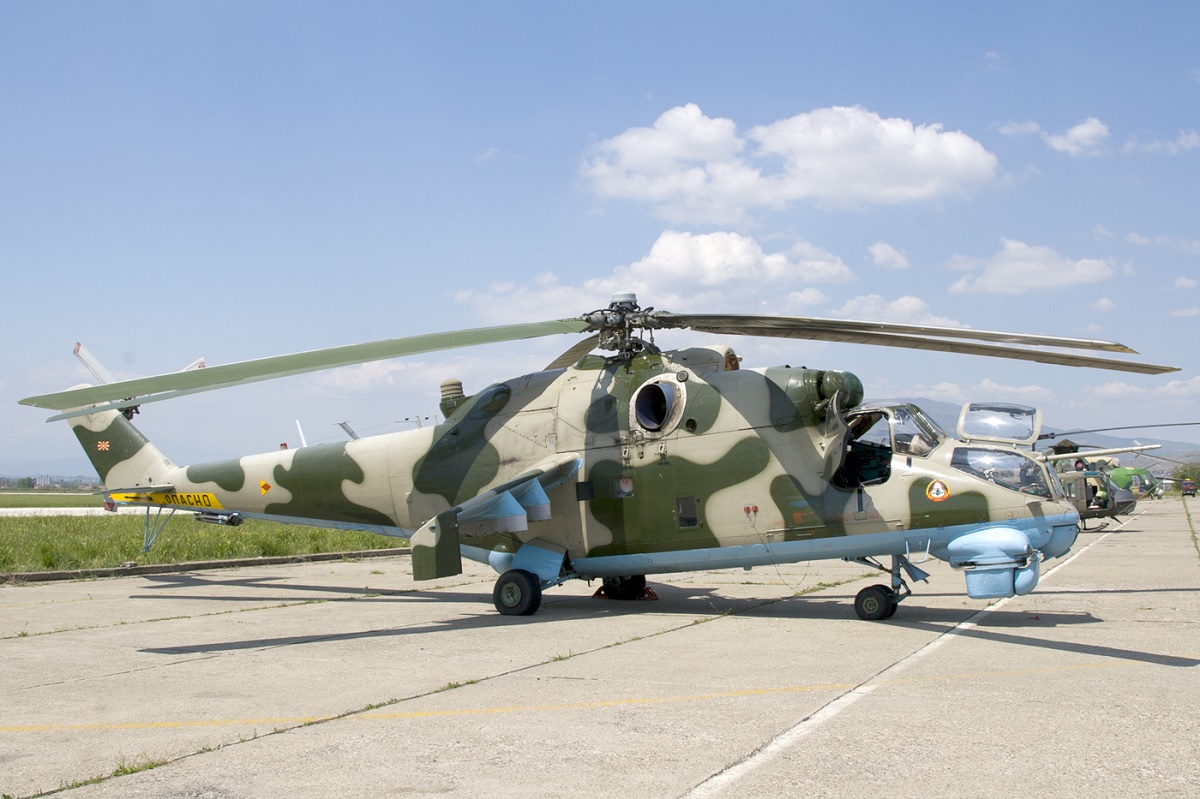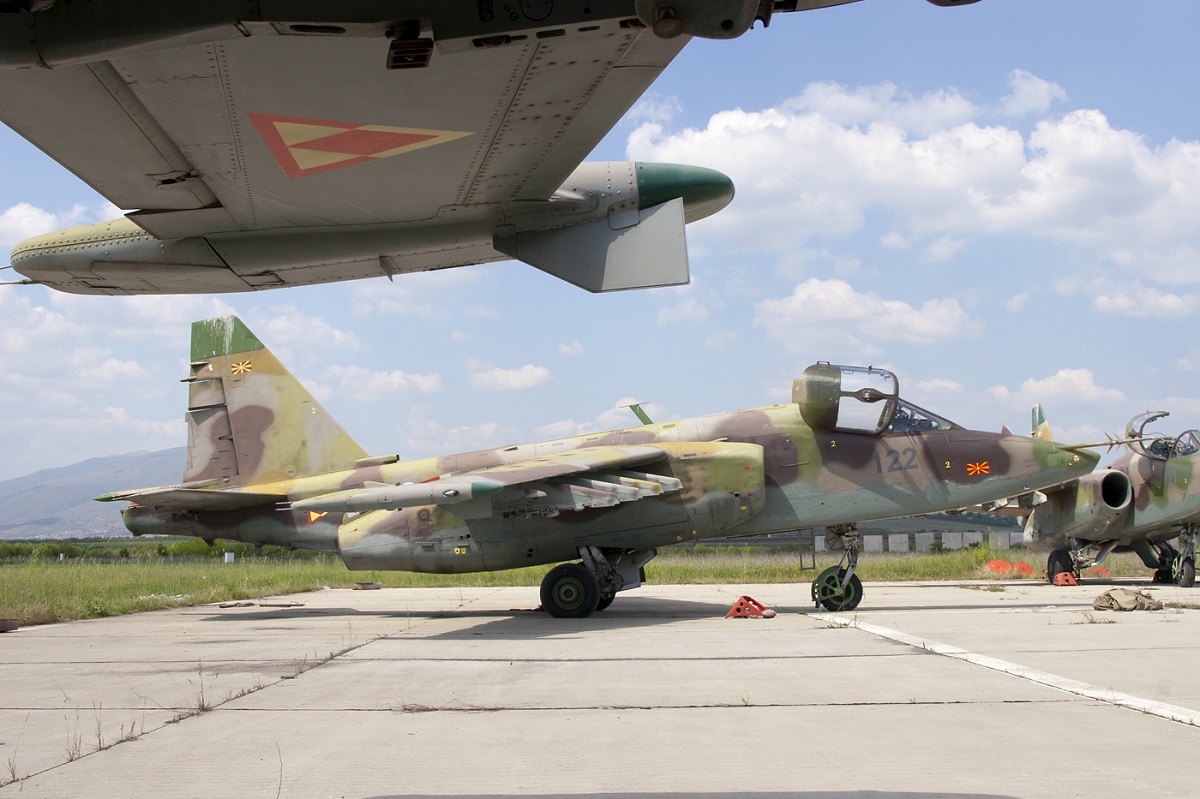Foreign-piloted Mi-24V helicopters turned out to be the most crucial air asset in use during combat
Fighting continued throughout the former socialist countries of the Balkans after the conflict in Kosovo, which was resolved in the summer of 1999 after several days of airstrikes on Yugoslavia. Unlike the other federal republics, fighting began in the former Yugoslav Republic of Macedonia (now known as Northern Macedonia) in January 2001, leaving the previous socialist federacy without a conflict. The Macedonian army and special police conducted a ground operation against Albanian separatists operating in the north of the country, but the air force also participated to a lesser level.
When Macedonia declared its independence from the Yugoslav federation in 1992, its air force—then known as the Air and Anti-Aircraft Forces—had just a weak fleet. When war broke out in Yugoslavia in 1991, the 354th Reconnaissance Squadron and the 241st and 247th Fighter-Bomber Squadrons, equipped with J-21 Jastreb and J-22 Orao ground attack aircraft, respectively, were housed by the Yugoslav Air Force in Skopje, the capital of North Macedonia (Skanska Petro vac and Kraljevo airports).
Throughout the years 1991 and 1992, the entire brigade was operationally withdrawn from Macedonia. Organizationally, the Macedonian Air Force was founded in June of that year and received just one Utva-66 training aircraft with four seats and four Utva-75 A21 aircraft with two seats from its inventory.
These aircraft were originally owned by the Macedonian Air Union, not the Yugoslav Air Force, which gave them to the newly established Army Air Force for training. Due to the hostilities in Croatia and Bosnia and Herzegovina, North Macedonia had difficulty arming and increasing its military aviation inventory. UN Resolution 713, which was approved in September 1991, imposed an arms embargo on all countries of the former Yugoslavia (including later independent Macedonia). Macedonia said the embargo was unfair because it was the only nation to peacefully secede from the federation.
The government purchased four Antonov An-2 transport biplanes from Ukraine despite the embargo, but because of the international sanctions, they were nonetheless registered as civil aircraft. 1995 saw the acquisition of four Zlin 242L training planes from the Czech Republic.
After being relieved from the embargo in 1996, Macedonia’s air force bought its first new aircraft—four Mi-17 helicopters—from Ukraine. The L-39MS Albatross used F-5 fighter planes from Turkey, used MiG-21bis fighter jets, and Mi-24D attack helicopters from Bulgaria, as well as used Bo-105M helicopters from Germany, which were other potential aircraft for the planned upgrade of the Macedonian Air Force. All of these plans were unsuccessful.

Broke out of the conflict
Since the early 1990s, unrest has risen in the adjacent region of Kosovo. The Albanian population established the paramilitary organization Kosovo Liberation Army in an effort to wage a full-fighting war against the Yugoslav army. This conflict started in 1998.
The Macedonian Air Force Command made the tactical decision to relocate the aircraft deeper into the country in order to prevent it from becoming a potential target for local Albanian groups because a sizable Albanian population was also present in northern Macedonia. The Macedonian Air Force frequently performed reconnaissance flights over the Yugoslav province’s border during the Kosovo War in mountainous regions close to Kumanovo and Tetovo, just a few miles from the capital Skopje, where, according to the 1994 Census, 22,9% of the Albanian population resided.
By delivering food, water, and medical supplies to the refugee camps, the Mi-17 aircraft of the Macedonian Air Force assisted refugees from Kosovo traveling to Macedonia. The Macedonian Air Force did not record any serious incidents, with the exception of one of the Zlin Z242Ls from the Air Force that crashed on April 7, 1999, close to the village of Radoviš.
The Kosovo Liberation Army was disbanded after the Yugoslav army withdrew from Kosovo and KFOR troops took over the country. The Liberation Army of Prešev, Medvedjo, and Bujanovac was founded in the south of Serbia, and the Macedonian National Liberation Army was established in the north. However, its former members founded parallel organizations. Beginning in 2000, it only ever carried out relatively minor assaults on border posts and police stations to the north of Skopje.
The level of conflict peaked in March 2001, when the army and the air force were fully mobilized to combat the terrorist organization. The US Air Force employed MQ-1 Predator drones from the 11th Reconnaissance Squadron in Skopje, which were later replaced by Israeli RQ-5 Hunters from the Task Force Hunter, to monitor the chaotic area because it lacked its own observation aircraft. The survey of the Luna X-2000 was assisted by the German army.
The Macedonian Air Force received two Mi-24V helicopters and four Mi-8MT helicopters from Ukraine as part of a program to modernize its fleet. The Mi-8MT helicopters had previously been used by KFOR in Kosovo. Ukraine provided Macedonia with four additional Mi-24 helicopters in 2001 (two in April and two in September) as well as four Su-25 aircraft (three Su-25Ks and one Su-25UB), the first combat aircraft to enter Macedonian Air Force service. With the arrival of Mi-24Ks meant for artillery guidance and reconnaissance in December of that year, deliveries from Ukraine were completed.
In 2001, Greece shipped two UH-1H helicopters. A Britten-Norman BN2T-4S Defender reconnaissance aircraft from an unspecified country, six J-21 Jastreb fighters from Serbia, six MiG-29 fighters from Ukraine, two Kamov Ka-50 helicopters from Russia, or even an unspecified number of F-16C/Ds from Turkey. The Macedonian Ministry of Defense, however, denied these claims.
The support provided to government troops during their counteroffensive north of Tetovo on Mar. 25 was one of the Macedonian Air Force’s first combat missions. The army deployed the Mi-17 and Mi-8MT helicopters during the counteroffensive to move infantry units more quickly. No helicopters were lost despite the fact that Albanian separatists had a large number of FIM-92 Stinger and Strela-2M anti-aircraft mobile weapons at their disposal. On March 17, one Mi-17 was lost after the rear rotor blades crashed with the flagpole during takeoff from the Popova Šapka ski resort.

Macedonian Su-25s in a fight
During a short period of time, the Macedonian Air Force employed its only jet aircraft. In June 2001, Macedonia received four Su-25s from Ukraine (three Su-25Ks and one Su-25UB, originally owned by the Belarusian Air Force). The “Frogfoots” were flown by Ukrainian mercenary pilots since the service lacked trained pilots. On June 23, the Sukhois undertook a reconnaissance flight over the village of Aračinovo, which is close to Skopje, where severe combat was occurring. From the Petrovec air base, Sukhois took off. Later, while serving with the Macedonian Air Force, Su-25s flew just one combat flight. Separatists in Albania were successful in taking a T-55 tank from the Macedonian military in August.
On August 12, three Sukhois conducted a combat flight to try and destroy it. The machines attempted to strike the tank with unguided 57 mm missiles, but they were unsuccessful, according to the data that was available. The Frogfoots had engaged in a number of additional reconnaissance operations by the conclusion of the conflict in November 2001, most of which they carried out with Mi-24 helicopters, but no direct combat activity. The Su-25s were added to the 101st Squadron’s arsenal following the conflict, where they operated until 2003. Due to a shortage of pilots and spare components for the aircraft, the Frogfoots’ brief operation as the only jet fighters in the nation’s air force came to an end.
Macedonian Mi-24s in a fight
The Mi-24s provided to Macedonia were identical to the Mi-8MT, Mi-17, and Su-25 aircraft delivered from Ukraine. Twelve Mi-24s (variant Mi-24D and Mi-24V) were sent to Croatia in 1993 and 1994, hence the fighting in Macedonia was not the first for the Ukrainian Mi-24. Due mainly to the ongoing UN embargo, the equipment was shipped as rescue helicopters, and soon after their arrival in Croatia, the equipment was mounted on the choppers. During Operation Storm in August 1995, Croatian Mi-24s took part in the battle against local Serbian separatists.
When Yugoslavia started to take a less active role in the Kosovo conflict in 1998, several Mi-24Vs that were initially Ukrainian were also delivered to that nation. They only briefly served in the Yugoslav Air Force following the conflict. On March 23, 2001, Macedonia received its first supply of Mi-24 aircraft.
As in the case of the Su-25, the Macedonian Air Force’s “Hinds” were first flown by hired pilots from the post-Soviet republics because there were only two crews qualified to fly the Mi-24. On April 2, a combat flight against the positions of Albanian separatists north of Tetovo served as the Mi-24’s first combat operation. The employment of Macedonian Mi-24s in the conflict in the summer of 2001 was so intense, according to the sources that are available, that they purportedly destroyed all 57 mm missiles that were in the country.
During the conflict, Macedonian Hinds also employed roughly 40 Shturm-V anti-tank missiles, occasionally during night attacks. The Mi-24 also dropped four 250 kg bombs during the fighting for the village of Arainovo, which started on June 21 at 4:30 in the morning. Hinds crews frequently used flares during attacks on ground targets to stop Albanian militants from taking down helicopters with multiple MANPADS. Versions K and V of the Mi-24 joined the 201st Anti-Armor Helicopter Squadron after the conflict. The Mi-24K helicopters were eventually decommissioned, and currently, the Macedonian Air Force is equipped with four Mi-24V helicopters that Israeli company Elbit refurbished.
The dissolution of the Albanian separatist forces was a result of the end of the hostilities in northern Macedonia in November 2001. The only Mi-17 helicopter lost by the Macedonian Air Force during the conflict’s nearly one-year duration was not actively involved in the battle. Unknown is the precise number of flights made by the Macedonian Air Force throughout the conflict. Nonetheless, in a relatively short period of time, the air force of North Macedonia was able to successfully support ground troops in their conflict with nearby Albanian separatists. Foreign-piloted Mi-24V helicopters turned out to be the most crucial air asset in use during the war.
Due to logistical reasons, the Su-25K and Su-25UB attack aircraft were only ever employed once to directly strike ground targets. Smaller skirmishes with the Albanian minority also occurred in Northern Macedonia in 2015, but thankfully they were not as severe as they were in 2001 and the air force did not have to be involved.

Sources
Alexander Mladenov: Mil Mi-24 Hind Gunship. Osprey Publishing, 2010.
Alexander Mladenov: Su-25 Frogfoot Units in Combat. Osprey Publishing, 2015.
Alexander Mladenov: Sukhoi Su-25 Frogfoot. Osprey Publishing, 2013.
Photo by Mi-24K and Su-25Ks Rob Schleiffert via Flickr and Skopski Petrovac, Own work via Wikipedia

